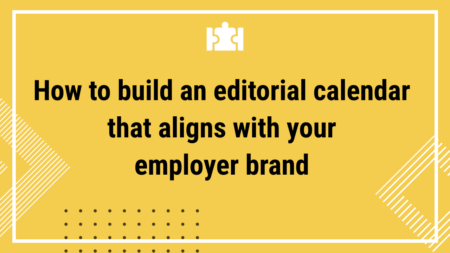Business leaders are dealing with unforeseen challenges marked by geopolitical instability, economic volatility, and the consequences left by the COVID-19 pandemic. On top of that, they’re navigating a range of organizational shifts with notable implications for people, processes, and structures. The majority are aiming to find answers to critical questions on:
- How to address the declining mental health of their employees
- How to streamline workflow and speed resilience
- How to retain talent & improve internal employee engagement
- How to find true balance between remote and in-office work models
For many years, having a defined employer brand was a trend that only “privileged” corporations could afford to explore. Between 2020 and 2023, that myth was debunked as many realized that employer branding is a must, not a nice-to-have. This realization emerged after the employment market shifted from an employer’s market to a candidate’s market.
As organizations acknowledged the importance of having a strong EVP and an honest company culture, employer branding became the solution to attracting and retaining top talent. And yet, 2023 brought unexpected events in employer branding, most of them stemming from the aftermath of the massive layoffs phenomena of 2022. This downturn prompted widespread budgetary constraints across various sectors.
Read on to learn more about the trends in employer branding for 2024.
#1 Talent attraction gets personal
Although the wave of layoffs in tech accentuated throughout 2023, it would be unrealistic to expect 2024 to become an employer’s market. We’ve seen many organizations switch off external activities related to attracting talent, with the majority maintaining their focus on keeping internal employee engagement. As a result, it is anticipated that 2024 will be about customizing employee work policies.
For recent hires, the focus could be on offering better learning and development opportunities in-person, in the office. For seniors and high-performers, the focus could be on providing better flexibility or a more diversified benefits package. In an uncertain macroeconomic climate, external hiring becomes a luxury. This means that organizations will look inward to give new opportunities or learnings to existing team members.
Takeaway
A personalized approach to attracting talent in 2024 will help employees decide whether they fit a certain company culture or not. From a business perspective, the strategy could be about setting priorities straight from the get-go. From our experience, after working with tens of companies in tech on building their employer brand image, we’ve noticed a need: amid severe budget cuts, organizations no longer have the resources to work with agencies on building EVPs. However, they need the hands-on experience of an agency to train current in-house employees on employer branding best practices.
#2 AI in employer branding: a major disruptor in content personalization
Over the past decade, artificial intelligence (AI) has proven its transformative capabilities across industries. In talent management, it innovates content creation, enabling greater creativity in crafting stories. A recent study shows that 82% of senior leaders and CEOs expect AI to have a strong impact on their business. In recruitment, it speeds processes, powering interview pre-screening and candidate assessment.
Used right, AI saves time and money by streamlining processes, automating tasks, and supporting data-driven decision-making. In short, it helps hiring managers gather valuable insights into employee engagement, identifying areas for improvement and contributing to building a positive workplace environment.
Takeaway
In 2024, we expect more companies to integrate AI into their employer brand initiatives. Content personalization means diversification; and diversification will help hiring managers reach more accurate audience segments. Rather than depending on one-size-fits-all solutions, employers will use AI technology to communicate messages with better precision across various channels.
#3 Tailored EVPs that help close the gap between what organizations want and what workers need
The concept of Employee Value Propositions (EVPs) is undergoing a transformative evolution. This evolution is marked by a strategic shift towards tailoring EVPs to bridge the gap between organizational objectives and the diverse needs of workers. A one-size-fits-all approach is no longer sufficient, as the workforce becomes increasingly diverse, catering to the varied expectations, aspirations, and priorities of candidates and employees.
Recent research shows that a solid EVP can lower turnover by 69%. As a result, a tailored EVP holds the key to not only attracting top talent but also fostering long-term employee engagement. By recognizing and addressing the individual needs of employees, organizations can create a more inclusive and fulfilling work environment. Mckinsey’s latest report argues that, in Europe, 35% of employees leaving their organizations cite unrealistic performance expectations. To bridge this gap, leaders can respond by customizing EVPs to individual preferences. When employees perceive that their values align with the organization’s, and that their contributions are acknowledged and valued, it fosters a positive workplace culture.
This alignment not only boosts morale but also encourages employees to be more committed and motivated, leading to increased productivity and more cohesive, high-performing teams. In essence, a customized EVP creates an environment where employees feel a sense of purpose and fulfillment, contributing to long-term organizational success.
Takeaway
Customized EVPs go beyond traditional compensation and benefits packages. They delve into factors such as career development opportunities, work-life balance, and a supportive workplace culture. For instance, a younger workforce might prioritize professional growth and mentorship, while more experienced employees may value recognition.
For 2024, consider tailoring your EVP, which allows you to align your offerings with the specific needs mentioned above. This will create a mutually beneficial relationship that goes beyond the transactional aspects of the employer-employee contract.
#4 Strategic alignment: the quest for clarity to understand role value
McKinsey research shows that 20% to 30% of critical roles are not filled by the most qualified people. Only 5% of employees are high performers and are capable of delivering 95% of a company’s value. Furthermore, organizations that assign top employees to critical roles are 2 times more likely to outperform their competitors.
Most large organizations reap disproportionate benefits from their 25 to 50 roles that are scattered across different levels and functions. Many are uncertain about which roles are the most critical, where the high performers are in their organizations, and how to bring the two together.
With 34% of leaders mentioning that they have some clarity on role importance for organizational value, it’s safe to assume that 2024 will be about better assessing the notion of “putting the right people in the right roles”. So far, 20% of critical roles either don’t exist or have evolved in scope. To help leaders and hiring managers become better “matchmakers”, the key is to:
- Redefine role structures
- Understand what “great” means for specific high-value roles
- Write a checklist of attributes, skills, and experiences needed for an employee to succeed in X role
- Leverage all performance data at hand to help you get insights on what makes X role valuable
- Customize job descriptions and job ads
- Make sure role expectations and allocated budget for X role meet halfway through
Takeaway
Strategic role alignment is pivotal for organizational success. Sadly, a significant portion of critical roles remains unfilled by the most qualified candidates. The challenge lies in the lack of clarity among organizations when it comes to identifying these critical roles and aligning high performers with them. Organizations should focus on refining their approach to talent placement in 2024. Industry research points out that there’s a form of cautious optimism in recruitment as C-suite executives work their way to balance gradual market recovery with economic challenges.
Although it’s difficult to determine if recruitment will get back on track, one thing’s for sure: 2024 calls for a strategic evaluation of compensation structures, benefits packages, and incentives to ensure market competitiveness. A holistic approach includes initiatives aimed at enhancing the overall employee experience, acknowledging that retention is not solely contingent on monetary factors. Investing in professional development programs, mentorship opportunities, and a positive work culture not only fortifies the organizational foundation but also fosters a sense of loyalty among employees.
#5 Declining leadership buy-in & the need for external help in EB
Although leaders are waking up to the challenges facing their organizations, we’ve seen business priorities change massively in 2023. The 2nd wave of layoffs was the wake-up call that revealed a crucial insight: Employee Value Propositions (EVPs) are not authentic enough.
Some organizations and C-suite executives acknowledged the importance of leadership buy-in and the benefits it can bring to an organization. But this year’s economic turmoil forced many to switch focus: from people, employer branding, and recruitment to saving money at all costs. For 2024, we should expect leadership buy-in to decline even more as the labor market closes the year on a puzzling note: job ads dropped 22.5% since their peak time in December 2021.
“The CEO role is decisive: what a CEO controls accounts for 45 percent of a company’s performance. And a CEO’s ability to scale leadership throughout an organization—that is, affecting people’s immediate bosses and how they lead others—is an important facilitator or blocker for employee experience”.
(McKinsey – The State of Organisations 2023)
In the absence of open roles and new hires, C-suite executives stopped taking employer branding seriously. Amid massive budget cuts and little recruitment needs, talent and people departments were left with zero resources to maintain employee engagement or work on developing their EVPs. In conclusion, the central challenge facing CEOs and other C-suite leaders in 2024 will probably be about retaining current employees via internal employer branding initiatives.
Takeaway
After a series of events and conferences we’ve had the pleasure of attending this year, we’ve learned an important lesson: there are ways and strategies to build an employer brand on a budget. But you need an external partner with real know-how to guide you and your people on that path.
“The last few months in the business world have been like a rollercoaster. Employer branding practices seemed to have lost their shine as companies made difficult decisions like layoffs and budget cuts, and the air was thick with uncertainty and fear. Despite these challenges, my experiences at various conferences on employer branding, leadership, and HR in 2023 have highlighted a significant truth: it’s tough to figure out how to be authentic in employer branding. It’s even tougher for organizations to admit that they need external help.
Many companies shy away from this because they tend to approach their identity on a surface level. They rarely take a deep look inside, tell the honest truth, admit to mistakes, learn from them, and strive to improve.”
– Georgiana Ghiciuc, CEO & founder of EmployerBranding.Tech
#6 Matching candidate wants with organizational needs
Candidate experience impacts the way external candidates perceive a company; a perception that builds up following multiple candidate-company interactions, ultimately shaping the employer brand. Whether good, bad, or neutral, your reputation as an employer draws candidates in or out of your recruiting funnel. In this context, a strong employer brand can drastically increase retention, reducing employee turnover by nearly 28%.
How candidates are treated reflects upon how employees are treated. If you’re not dedicated to creating a positive first impression, you won’t be able to transform candidates into new employees. Sadly, this wasn’t the case for 2023, at least in tech. Rather than being candidate-centric, 2023 was candidate-static, and the anticipated Great Retention trend of 2022 became the Great Stagnation throughout 2023.
Takeaway
There are two critical parts of the employee journey that organizations still fail to master – onboarding & offboarding. Research by Gallup mentions that only 12% of employees say their organizations have a proper onboarding process in place, and 33% would leave their job following a negative experience. And it’s safe to say that 2023 was plagued with negativity.
The key to matching candidate wants with organizational needs begins internally. We anticipate that 2024 will have a greater focus on the entire employee lifecycle, from onboarding to offboarding. Successful employee onboarding/offboarding is dynamic, and it’s time to accept that one-size-fits-all methodologies won’t help with retention in the long term.
A top priority companies have for the next year is retention of current people and focus on strengthening internal employer branding initiatives. To do that successfully, onboarding needs to be customized per role, or at the very least, role cluster. Believe it or not, 71% of organizations don’t have an official offboarding process in place, although 87% of HR professionals believe that it matters just as much as onboarding. What organizations still fail to understand (and hopefully will change next year) is that if it’s not meant to be, it’s not meant to be NOW.
Closing thoughts
Trends and predictions aside, 2024 in employer branding will be about working with what you already have to improve your existing culture, whether it’s good, bad or neutral. Regardless of budget cuts, economic uncertainty, or additional trends impacting the job market, it’s worth remembering that “organizations are not ethereal, foreign, distinct organisms that live in secluded spaces where people go to get paid every month. NO! An organization is a sum of individuals and every organization is as strong as its weakest member”.
With that thought in mind, let us remember that all the resources we need to build a strong employer brand in 2024 already exist. Those resources are your people, and all of them want you to listen more to what truly hurts them (or makes them happy). It could be money, but it could be so much more than that. Unless questions are addressed and trust is offered with open arms, no employer brand can be truly honest.





